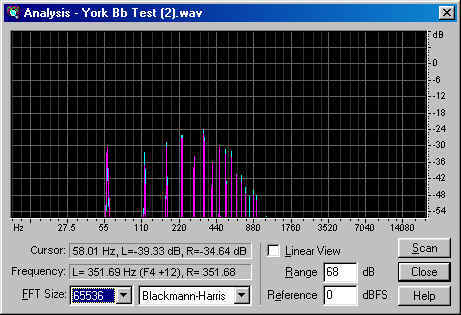Here's the spectrum of a tuba (a 58-Hz low Bb), measured by me at least 25 years ago:
I've heard systems that make a tuba sound like a euphonium, or a horn sound like a trombone. In the former case, a lot of odd-order harmonics de-emphasize the spacing of the harmonics, and emphasize the overtones that would normally be related to the note an octave higher. Yes, it takes a lot of distortion to make this happen, but maybe not as much as we think.
A horn sounding like a trombone can simply be plain old distortion of the usual kind: an emphasis of high harmonics in the mix, particularly as a result of clipping distortion. Trombones have edge in the sound not present in horns (unless played fully stopped, but that's not likely to be mistaken for a trombone). That edge is what? Non-harmonic high frequencies and sibilance. IMD might product something like that if severe. But a spectral tile that depresses frequencies can do it, too. An F horn has the same length tubing as an F tuba (half again longer than at trombone), and though the player is usually buzzing higher frequencies, there will be some excitation and resonance at the fundamental (though the fundamental of a Bb tuba in the FFT above is at 26 Hz, but my microphone probably couldn't pick that up--I think I recorded that on a Sony Minidisc recorder).
But mostly systems make tubas sound like euphoniums because they can't put enough power in the overtones under 200 Hz.
I'm not particularly sensitive to harmonic distortion, but I am particularly sensitive to tone color and spectral tilt.
Rick "thinking it unlikely that this is an amp problem unless overdriven" Denney

